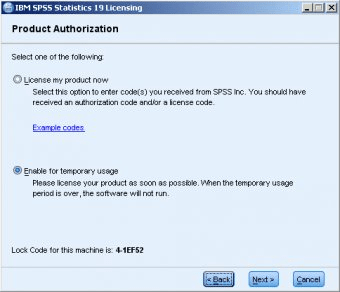
- #SPSS 16 LICENCE HOW TO#
- #SPSS 16 LICENCE MAC OS#
- #SPSS 16 LICENCE SOFTWARE DOWNLOAD#
- #SPSS 16 LICENCE INSTALL#
#SPSS 16 LICENCE INSTALL#
Once any other versions of SPSS have been uninstalled, please follow these directions to install SPSS:
#SPSS 16 LICENCE HOW TO#
For further directions please see IBM’s articles on How to Uninstall SPSS from a Mac or How to Uninstall SPSS from Windows. In order to install and license the campus version of SPSS, all other versions and/or trials of SPSS must be uninstalled from your computer.
#SPSS 16 LICENCE MAC OS#


There is also an introductory tutorial available in SPSS under Help. How can I learn it? OIT offers workshops on SPSS each semester, and you may schedule a one-on-one tutorial by calling the OIT HelpDesk at 86. There is no simultaneous user limit for SPSS. For UTK, SPSS is also available on OIT’s and on the computers in the OIT public computer labs.
#SPSS 16 LICENCE SOFTWARE DOWNLOAD#
The download and installation instructions are available at the OIT Software Download web page. Where can I run it? SPSS is available at no additional charge to faculty, staff and students at all UT campuses for installation on university-owned and personally-owned Windows, Macs and Linux computers. Use that benefits outside organizations requires the purchase of a commercial license. What can I use it for? Students, faculty, and staff can use SPSS for university-related academic (not administrative) purposes. The SPSS programming language can be used to automate repetitive tasks, to leave an audit trail of the steps you took, and to get the package to do something that it was not originally designed to do. While most users prefer the SPSS easy-to-use GUI interface, more advanced users can take advantage of its programming language. It is also easy to transfer data from SPSS into R or SAS to access any esoteric analyses.

It does a broad range of statistics and graphics, and it is easy to learn and use. What is it? SPSS Statistics is the most widely used statistics package at UT.


 0 kommentar(er)
0 kommentar(er)
